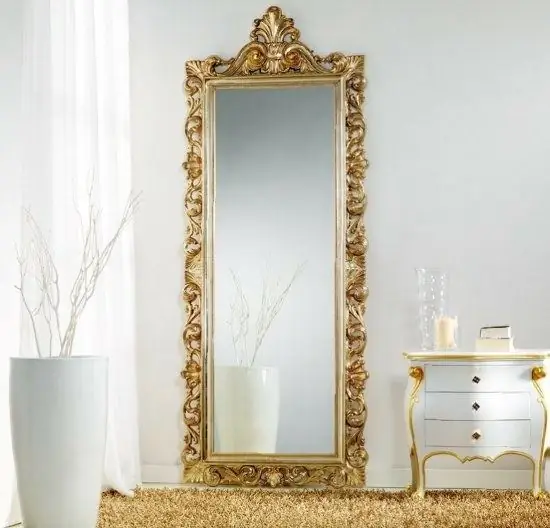- Author Nora Macey [email protected].
- Public 2023-12-16 10:17.
- Last modified 2025-01-23 08:47.
There has long been a belief that a person who often looks in the mirror gives up his vital energy to a reflection that exists in another, through the looking glass, world. If you remember that for a long time mercury was used in the manufacture of mirrors, the fumes of which are extremely toxic, the reasons for the appearance of the ancient warning will become clear.

Instructions
Step 1
The modern production of household mirrors has lost its most harmful component - mercury has been replaced by silver, sometimes aluminum is used. The required minimum set for the production of a future reflective surface: a sheet of glass, a fine abrasive for grinding it, degreasing agents, demineralized water for rinsing, tin, a solution of silver salts, reagents for a chemical reduction reaction, paint for applying a protective layer.
Step 2
Ordinary glass sheets are transported by a conveyor to the washing and grinding area with an abrasive powder - cerium oxide, an unstable rare earth metal from the lanthanide family. Both glass surfaces are brought to perfect smoothness and then washed with hot distilled water, which dissolves possible grease contamination and leaves no residue due to complete demineralization. Such purity is necessary to create an ideal reflective metal layer, because interaction with minerals remaining on the glass (in the case of washing with ordinary water) would entail coating defects.
Step 3
The next step is the preparation of glass for silvering. Since silver cannot fix directly on the glass surface, a thin layer of liquid tin comes to the rescue, which is sprayed onto polished and degreased glass. With it, when adding the necessary reagents, a solution of silver salts enters into a chemical reaction.
Step 4
As a result of silver hardening, a film with a reflective surface forms on the glass, which is extremely unstable, soft and requires a protective layer. Tested in the dark and free from defects in the coating (areas that do not reflect, but transmit light), the sheets are transferred to the next stage.
Step 5
Soft silver plating requires effective protection. A less durable mirror has just a thick layer of special paint on the back surface. The service life of the finished product is increased by spraying a thin film of copper onto a silver layer, on which a thick layer of paint is then applied in two steps. All these processes take place with intermediate drying at different temperatures. During the next quality check, areas with defects in the form of bubbles and dots are revealed, flawless fragments are left, the rejection is cut out and goes into battle.






